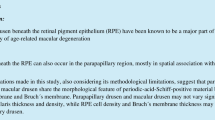Abstract
Purpose
To examine patterns of retinal pigment epithelial autofluorescence and lipofuscin accumulation in relation to drusen and to explore the pathogenesis of drusen in rhesus monkeys.
Methods
The macular areas of six rhesus monkeys, euthanized at 19 to 28 years of age, were studied by bright field and fluorescence light microscopy and transmission electron microscopy.
Results
There was strong autofluorescence in the retinal epithelium that tended to diminish over drusen. Electron microscopy revealed that all retinal epithelial cells had large concentrations of lipofuscin bodies. The epithelial cells overlying drusen, however, tended to have less lipofuscin than epithelial cells not associated with drusen. Electron microscopy revealed that the epithelial cells overlying drusen were losing segments of cytoplasm containing lipofuscin bodies. Macrophage-like cells were consistently present in Bruch’s membrane microns away from this lipofuscin-containing cytoplasmic material.
Conclusions
Retinal epithelial cells overlying drusen have less lipofuscin than neighboring epithelial cells. The loss of lipofuscin seems due to a loss of cytoplasm containing lipofuscin that contributes to drusen formation. Macrophages in Bruch’s membrane may be responsible for removing this lipofuscin debris. The results support in vivo studies showing reduced autofluorescence over drusen and support the “budding” of epithelial cytoplasm as a source of drusen material.












Similar content being viewed by others
References
Bok D (2002) New insights and new approaches toward the study of age-related macular degeneration. Proc Natl Acad Sci USA 99:14619–14621. doi:10.1073/pnas.242607899
Burns R, Feeney-Burns L (1980) Clinico-morphologic correlations of drusen of Bruch’s membrane. Trans Am Ophthalmol Soc 78:206–222
Delori FC, Fleckner MR, Goger DG, Weiter JJ, Dorey CK (2000) Autofluorescence distribution associated with drusen in age-related macular degeneration. Invest Ophthalmol Vis Sci 41:496–504
Donders FC (1855) Beitrage zur pathologischen Anatomie des Auges. Graefes Arch Clin Exp Ophthalmol 2:106–118. doi:10.1007/BF02720791
Farkas TG, Sylvester V, Archer D (1971) The ultrastructure of drusen. Am J Ophthalmol 71:1196–1205
Gouras P, Ivert L, Mattison JA, Landauer N, Neuringer M (submitted) Drusenoid maculopathy in rhesus monkeys: effects of age, gender and diet
Hageman GS, Luthert PJ, Chong VNH, Johnson LV, Anderson DH, Mullins RF (2001) An integrated hypothesis that considers drusen as biomarkers of immune-mediated processes at the RPE-Bruch’s membrane interface at in aging and age-related macular degeneration. Prog Retin Eye Res 20:705–732. doi:10.1016/S1350-9462(01)00010-6
Hogan MJ (1967) Bruch’s membrane and disease of the macula: Role of elastic tissue and collagen. Trans Ophthalmol Soc U K 87:113–161
Ishibashi T, Sorgente N, Patterson R, Ryan S (1986) Pathogenesis of drusen in the primate. Invest Ophthalmol Vis Sci 27:184–193
Killingsworth MC, Sarks JP, Sarks SH (1990) Macropages related to Bruch’s membrane in age-related macular degeneration. Eye 4:613–621
Mattison JA, Lane MA, Roth GS, Ingram DK (2003) Calorie restriction in rhesus monkeys. Exp Gerontol 38:35–46. doi:10.1016/S0531-5565(02)00146-8
Muller H (1856) Anatomische Beiträge zur Ophthalmologie. Graefes Arch Clin Exp Ophthalmol 2:1–69. doi:10.1007/BF02720657
Spencer WH (1965) Pathogenesis of macular degeneration: light microscopy. Trans Am Acad Ophthalmol Otolaryngol 69:662–667
Suter M, Remé CE, Grimm C, Wenzel A, Jaattela M, Esser P, Kociak N, Leist M, Richter C (2000) Age-related macular degeneration: The lipofuscin component A2E detaches pro-apoptotic proteins from mitochondria and induces apoptosis in mammalian retinal pigment epithelial cells. J Biol Chem 277:39625–39630
Acknowledgements
We thank Kristy Braun and Hild Kjeldbye for technical assistance and NEI grants EY015293 and RR00163, The Foundation Fighting Blindness and Research to Prevent Blindness Inc. for support.
Author information
Authors and Affiliations
Corresponding author
Additional information
The authors have no proprietary interest to report.
The authors have full control of all primary data, and agree to allow Graefe’s Archive for Clinical and Experimental Ophthalmology to review our data upon request.
Rights and permissions
About this article
Cite this article
Gouras, P., Ivert, L., Mattison, J.A. et al. Drusenoid maculopathy in rhesus monkeys: autofluorescence, lipofuscin and drusen pathogenesis. Graefes Arch Clin Exp Ophthalmol 246, 1403–1411 (2008). https://doi.org/10.1007/s00417-008-0911-7
Received:
Revised:
Accepted:
Published:
Issue Date:
DOI: https://doi.org/10.1007/s00417-008-0911-7




